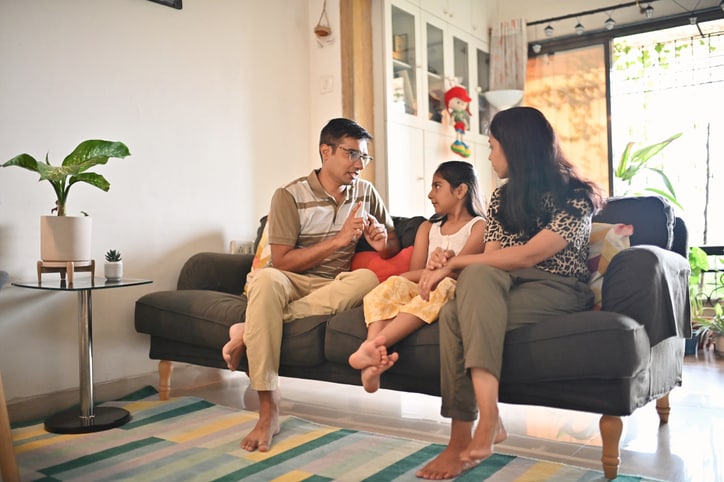In this article
- The importance of maintaining stable child care during divorce
- How to effectively communicate about child care while divorcing
- How to establish a co-parenting plan for child care
- How to collaborate with child care providers while going through divorce
- The bottom line on navigating child care during divorce
Like many aspects of home life during a divorce, your existing child care plan might require a makeover. Divorce may necessitate one partner returning to the workforce after having been a stay-at-home parent. Previous child care arrangements with an in-law may no longer seem feasible due to family dynamics. Regardless of the exact situation, experts agree that solutions need to center on the answer to one simple question: What is in the best interest of the child or children?
To that end, parents will do well to maintain whatever consistency they can when it comes to child care during the transition of divorce, says Ann Gold Buscho, psychologist and author of “The Parent’s Guide to Birdnesting: A Child-Centered Solution to Co-Parenting During Separation and Divorce.” While the status quo may be feasible for some post-marriage, other co-parents may need to rethink their game plan. Read on for expert insight on on the considerations and conversations that should go into creating your child care plan.
Key takeaways
- Divorce often requires reworking child care, but experts stress that decisions should always center on what’s best for the child. Maintaining familiar routines and caregivers where possible can reduce anxiety and help children feel grounded during a time of major change.
- Effective communication between co-parents is essential, even after the romantic relationship ends. Viewing co-parenting as a shared “business” and seeking mediation or professional support when needed can help parents create stable, child-focused plans.
- A strong post-divorce child care plan prioritizes consistency, clear rules, and collaboration with caregivers. Tools like shared calendars, agreed-upon routines and unified communication help children feel secure and supported across both households.
The importance of maintaining stable child care during divorce
Divorce, whether amicable or not, can be a very stressful time for all involved. While parents understand why it is happening, it may not be as clear to the children. They may process it in different ways, depending on their age. But no matter what they comprehend about the situation, parents want to try to avoid spurring anxiety, depression and confusion, says Gold Buscho.
Routines and consistency have a protective effect, according to a study published in the Journal of Family Theory and Review. Researchers note, “Routine disruptions can negatively affect children’s well-being post-divorce, but consistent routines can lessen stress and improve outcomes.”
While these negative feelings are likely unavoidable to a certain extent, Lauren Cook, a clinical psychologist and author of “Generation Anxiety,” agrees that consistent child care during and after divorce should be the utmost priority, if possible. “With so much change that’s happening in the child’s life, the more consistency and grounding they can have, the better,” she says.
“With so much change that’s happening in the child’s life, the more consistency and grounding they can have, the better.”
— Lauren Cook, clinical psychologist and author of “Generation Anxiety”
How to effectively communicate about child care while divorcing
Despite the marriage ending, parents still have to continue working together to varying degrees to care for their children, assuming both parents are physically and mentally capable of doing so. This can be a tough shift to make, but Gold Buscho advises a different perspective to effectively work as a team.
“You are no longer married, romantic partners, but you are partners now in the business of raising your children,” she explains. “You have to work together to make the business successful.” Not to mention that your position in the business of raising kids is potentially the highest-impact one you’ll ever hold. That mindset can help redefine the relationship, points out Gold Buscho.
Disagreements may come up during this process, sure, but most are solvable, as long as both partners want to find solutions and neither parent is dealing with issues that would make them an unsafe caregiver. That said, if safety is a concern, or parents are having trouble communicating effectively between themselves, Cook recommends reaching out to a therapist or getting another professional involved, such as a mediator, before attempting to set up a child care plan.
How to establish a co-parenting plan for child care
First and foremost, experts and parents agree that any child care plan you devise must prioritize a child’s needs. Cassandra Heston, a parent of two in Minnesota, recommends not only keeping “everything about the kids” but also trying to keep your emotions out of it. Being respectful to one another and doing your best to continue to present a united front will maintain a sense of normality for the children.
And don’t forget to let your kids weigh in regarding the current child care, as well, says Cook. “It’s really important that we ask them what their preferences are, what they’re liking, what they’re not liking and then, actually honoring what they share,” she says.
This open communication will also allow you and your partner to keep tabs on what’s working and what’s not. Here, a few more must-dos as you co-create your child care plan after divorce.
Agree on the basics
Anyone who has hired a babysitter or nanny knows numerous factors go into choosing a child care provider. For example, if schedule flexibility would make things easier, perhaps a nanny or au pair is preferable to a daycare.
Or if socialization is a concern, a daycare might be more your speed. Regardless, Danielle Sadler, former marketing director at Adventure Nannies, advises creating a job description and contract as well as reviewing your budget and the number of hours you’ll need the caregiver.
She also recommends writing down “educational goals, limits on screen time and any cultural or religious practices that should be observed,” which will contribute to consistent care for your child.
Give each other veto power
Once you’ve agreed on the basics of child care, Gold Buscho says both parents should be allowed to veto a provider for any reason. In addition to keeping the peace and keeping things equitable between co-parents, kids can sense when parents are in agreement or not, she points out. Maintaining that unity makes things feel more stable for the children, ultimately bolstering harmony for everyone involved.
Keep your child’s routine as consistent as possible
While certain situations may necessitate a change or addition of child care (such as one parent moving further away), try to stick to your existing child care routine as much as possiblen.
Gold Buscho offers the example of a grandmother picking the kids up on Wednesdays to watch them for a few hours. Continue that tradition post-marriage, encourages Gold Buscho, regardless of whose parenting time it is, officially.
If things do have to change, she suggests talking to your child about not only what will change but what will stay the same. For example, remind them that they will still have their same friends, and they’ll still see their grandma on Wednesdays. This reassurance and honesty can help prepare them for what to expect.
Don’t involve outside relationships
Gold Buscho recommends holding certain boundaries like not allowing new partners to babysit. This also naturally extends to including a first “right of refusal” in your child care plan. This means that if you or your co-parent would need alternate child care during “your time,” you’d offer that time to the other partner before seeking out a babysitter or other caregiver.
Create a calendar for the kids
Regardless of age, visuals can be really helpful for kids to know what to expect. Gold Buscho suggests keeping a calendar on the refrigerator or another high-traffic area. This will allow them to quickly glance and see who’s going to pick them up for school or who will put them to bed that night.
Keep a calendar on the refrigerator or another high-traffic area. This will allow kids to quickly glance and see who’s going to pick them up for school or who will put them to bed that night.
— Ann Gold Buscho, psychologist and author of “The Parent’s Guide to Birdnesting: A Child-Centered Solution to Co-Parenting During Separation and Divorce”
How to collaborate with child care providers while going through divorce
To keep all aspects of a child’s life as stable as possible, it’s vital to work alongside your child care providers. “Focusing on clear, collaborative communication and consistent caregiving practices will benefit the child and the child care provider,” says Sadler. To keep those lines of communication free of kinks, she shares the following tips.
Create a shared communication thread
“Lack of clear communication or conflicting instructions from co-parents can create confusion and make it difficult for nannies to perform their duties effectively,” says Sadler. Whether it’s through a nanny-parent communication app like Rayz Kidz or simply a group chat, keeping an open line of communication will make it easier for you to share updates and adjustments to a child care plan and to avoid crossed wires, explains Sadler.
Share your routines and rules
Because child care providers may spend a large chunk of time with your child it’s important to give them all of the information and tools they need to be the best caregiver possible. “Parents should share any agreements or arrangements they’ve made regarding the child’s care, including schedules, dietary restrictions, bedtime routines and how they wish to handle discipline or reward systems,” notes Sadler.
And don’t forget how important it is to be on the same page as your co-parent. “Keeping routines and rules consistent across both households gives the child a sense of security and stability,” she adds.
Communicate and be present
Cook advises notifying the child care providers of your family’s changing dynamic and asking for feedback as time goes on. You can ask questions like, “Are you noticing any changes in my child?” or “How do they seem to be adjusting?”
And if your child is in daycare, Cook suggests volunteering or staying with your child for a while after drop-off to see how they’re adapting to their environment.
These moves will ensure behavioral changes don’t go unnoticed, she says. It will also reaffirm to your child that “they’re not going to go through this alone.”
The bottom line on navigating child care during divorce
At the end of the day, the ideal child care plan between co-parents results from respectful and thoughtful discussion that centers the child’s needs. And those discussions will need to run the gamut of schedule, nanny vs. daycare, reward and punishment systems and more. The experts we spoke to agree that most parents want what’s best for their children, so if things get heated, co-parents would do well to refocus on their child or children’s needs.
Ultimately, being successful in creating a post-divorce child care plan with your co-parent centers on two main aspects: communication and consistency. As Gold Buscho concludes, there will be challenges, but at the end of the day, every choice should be oriented toward your child feeling loved by both parents, parented by both parents, secure and safe.





